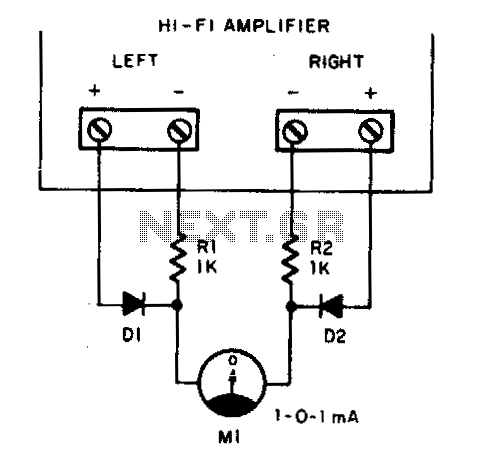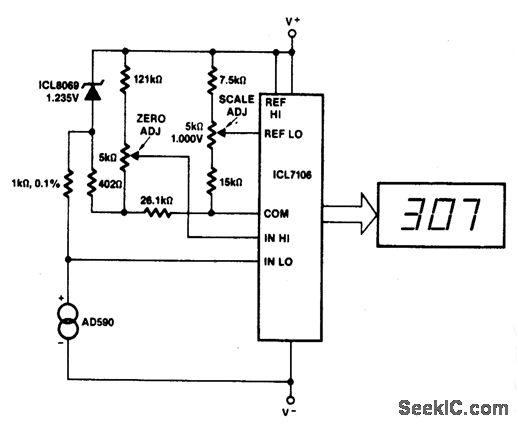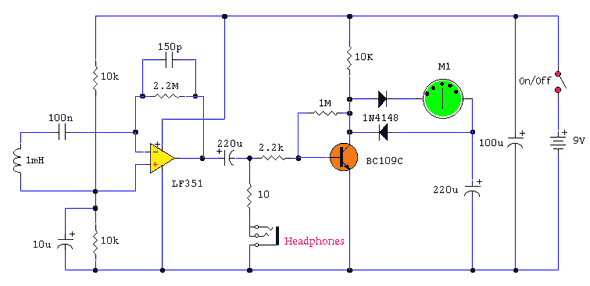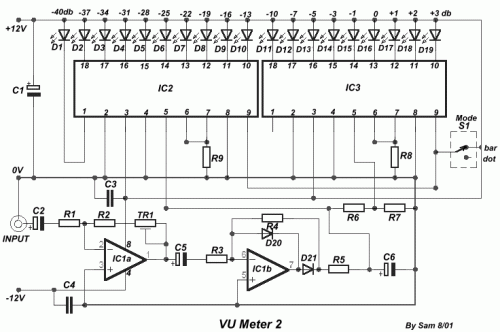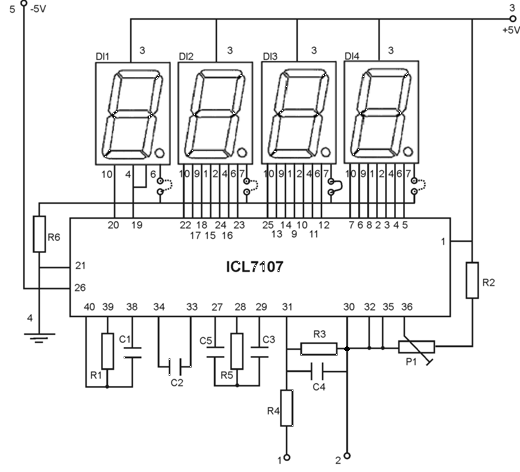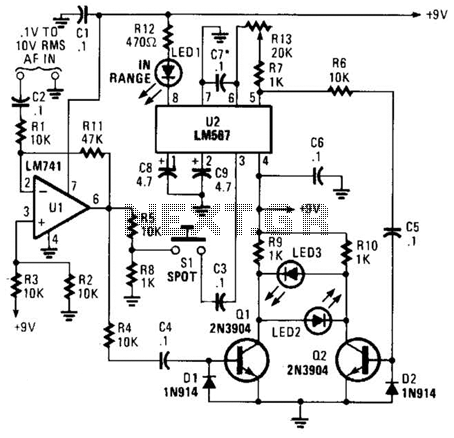
VSWR METER
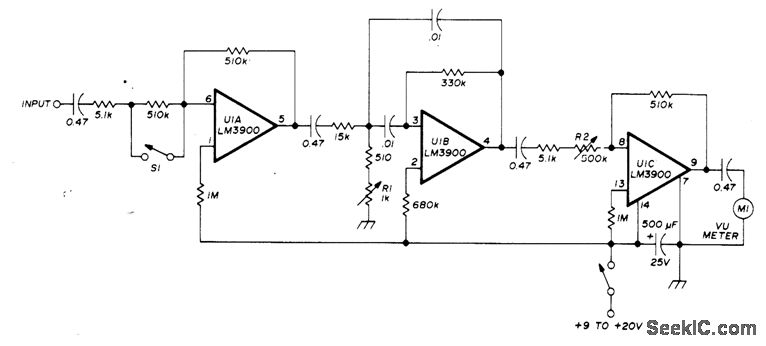
A simple and easily transportable VSWR meter is composed of a high-gain amplifier, a narrow-bandwidth selective amplifier tuned to 1000 Hz with a bandwidth of 100 Hz, and a variable-gain output amplifier that drives a low-cost VU meter. This device is ideally suited for nulling-type VSWR measurements and consumes approximately 6 mA from a 9 V transistor battery. Activating switch S1 increases the gain by approximately 100 times for low-level readings. Resistor R1 is used to set the frequency of U1B to 1000 Hz, while resistor R2 establishes the reference level on the VU meter.
The VSWR meter is designed to provide accurate measurements of voltage standing wave ratio (VSWR) in radio frequency applications. The high-gain amplifier enhances the input signal, allowing for better resolution of low-level signals that are typically encountered in VSWR measurements. The selective amplifier, with its narrow bandwidth of 100 Hz, ensures that only the desired signal frequency of 1000 Hz is processed, effectively filtering out unwanted noise and interference.
The variable-gain output amplifier allows the user to adjust the output signal to suit the sensitivity of the connected VU meter. This flexibility is crucial for adapting to different measurement environments and signal strengths. The low-cost VU meter serves as a visual indicator of the VSWR, providing an easy-to-read output for users.
The current draw of approximately 6 mA from a 9 V battery makes this design energy-efficient, allowing for prolonged use in field applications without frequent battery changes. The inclusion of switch S1 to increase the gain is particularly useful for low-level signals, enhancing the meter's capability to detect and display small variations in VSWR.
Resistor R1 plays a critical role in setting the frequency of the selective amplifier, ensuring that it is accurately tuned to the desired frequency of 1000 Hz. Meanwhile, resistor R2 is essential for calibrating the VU meter, allowing for precise readings that are essential for effective antenna matching and system optimization.
Overall, this VSWR meter design is a practical tool for radio amateurs and professionals alike, facilitating the analysis and tuning of VHF/UHF antennas with ease. Its compact size, low power consumption, and user-friendly features make it an invaluable asset in the field of radio frequency engineering.Simple, easily transported VSWR meter consists of high-gain amplifier, narrow-bandwidth (100-Hz) selective amplifier tuned to 1000 Hz, and variable-gain output amplifier driving low-cost VU meter. Ideal for nulling type VSWR measurements. Draws only about 6mA from 9. V transistor battery. Closing S1 increases gain about 100 times for Iow. Ievel read ings. R1 sets U1B to 1000 Hz, while R2 sets reference on VU meter. -J. Reisert Matching Techniques for VHF/UHF Antennas, Ham Fladio, July 1976, p50-56. 🔗 External reference
The VSWR meter is designed to provide accurate measurements of voltage standing wave ratio (VSWR) in radio frequency applications. The high-gain amplifier enhances the input signal, allowing for better resolution of low-level signals that are typically encountered in VSWR measurements. The selective amplifier, with its narrow bandwidth of 100 Hz, ensures that only the desired signal frequency of 1000 Hz is processed, effectively filtering out unwanted noise and interference.
The variable-gain output amplifier allows the user to adjust the output signal to suit the sensitivity of the connected VU meter. This flexibility is crucial for adapting to different measurement environments and signal strengths. The low-cost VU meter serves as a visual indicator of the VSWR, providing an easy-to-read output for users.
The current draw of approximately 6 mA from a 9 V battery makes this design energy-efficient, allowing for prolonged use in field applications without frequent battery changes. The inclusion of switch S1 to increase the gain is particularly useful for low-level signals, enhancing the meter's capability to detect and display small variations in VSWR.
Resistor R1 plays a critical role in setting the frequency of the selective amplifier, ensuring that it is accurately tuned to the desired frequency of 1000 Hz. Meanwhile, resistor R2 is essential for calibrating the VU meter, allowing for precise readings that are essential for effective antenna matching and system optimization.
Overall, this VSWR meter design is a practical tool for radio amateurs and professionals alike, facilitating the analysis and tuning of VHF/UHF antennas with ease. Its compact size, low power consumption, and user-friendly features make it an invaluable asset in the field of radio frequency engineering.Simple, easily transported VSWR meter consists of high-gain amplifier, narrow-bandwidth (100-Hz) selective amplifier tuned to 1000 Hz, and variable-gain output amplifier driving low-cost VU meter. Ideal for nulling type VSWR measurements. Draws only about 6mA from 9. V transistor battery. Closing S1 increases gain about 100 times for Iow. Ievel read ings. R1 sets U1B to 1000 Hz, while R2 sets reference on VU meter. -J. Reisert Matching Techniques for VHF/UHF Antennas, Ham Fladio, July 1976, p50-56. 🔗 External reference
Warning: include(partials/cookie-banner.php): Failed to open stream: Permission denied in /var/www/html/nextgr/view-circuit.php on line 713
Warning: include(): Failed opening 'partials/cookie-banner.php' for inclusion (include_path='.:/usr/share/php') in /var/www/html/nextgr/view-circuit.php on line 713
